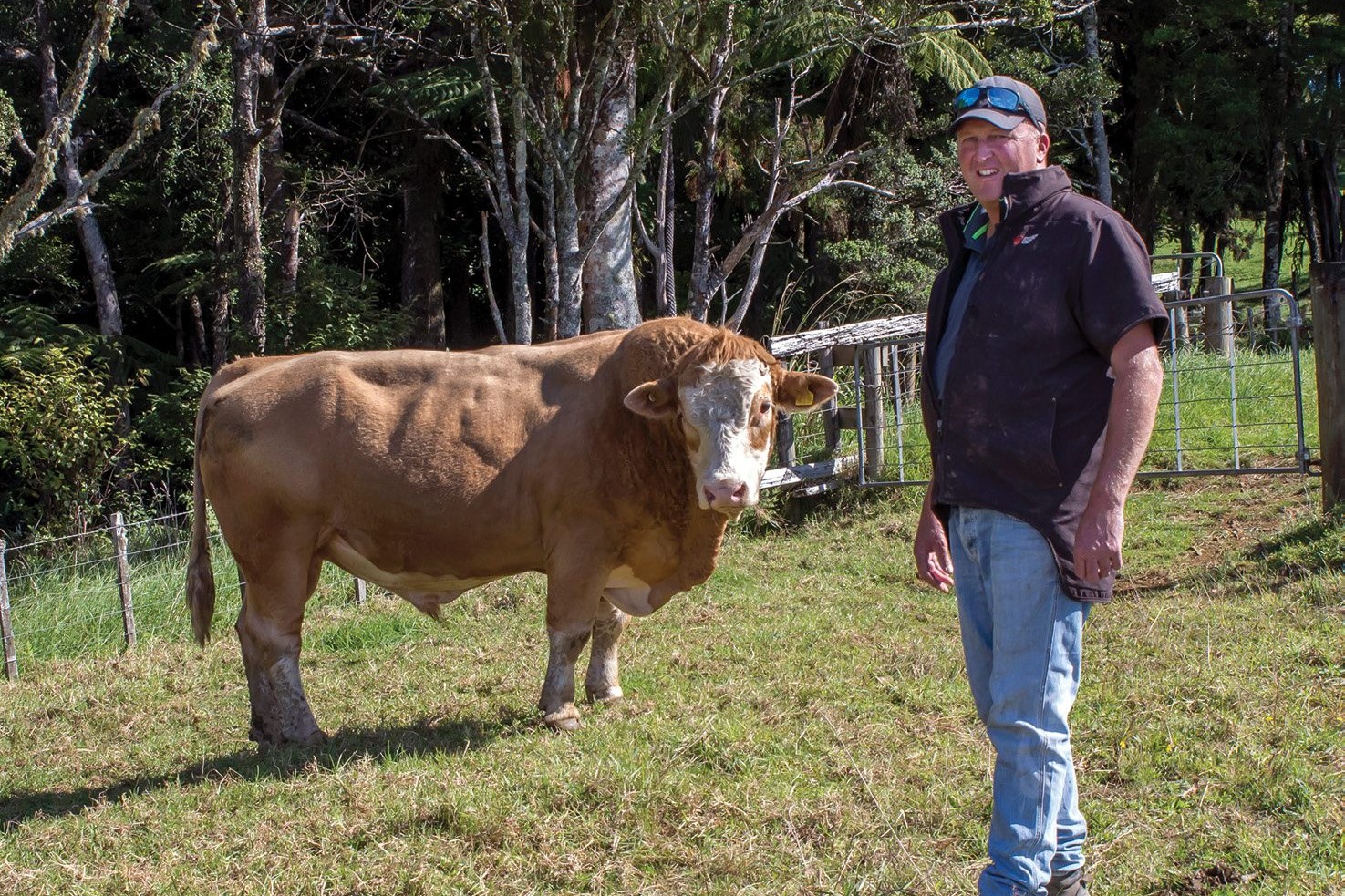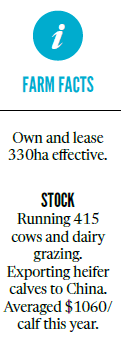Bull selection is paramount
A bigger mob is taking the pressure off kikuyu pasture at a Far North farm - and cutting the use of diesel. By Glenys Christian. Photos by Malcolm Pullman.

A bigger mob is taking the pressure off kikuyu pasture at a Far North farm – and cutting the use of diesel. By Glenys Christian. Photos by Malcolm Pullman.
Northland beef farmer and stock agent Reuben Wright owns a mulcher he won’t be using it this year on his two farms’ kikuyu pastures.
Due to the high cost of diesel he’s decided to put his cattle in a bigger mob to boost the grazing pressure across his paddocks.
While 60 cows in a mob would be the norm he’s now got up to 240 head on a 65-day round and says it’s working well.
“Usually I’m heavily into kikuyu mulching,” he says.
“But I’m not doing it at all this year with the high cost of diesel. I have a mulcher but it’s all about cost.”
Buying and selling farms around Kaitaia has seen him and wife Lisa buy an 88ha farm, which used to run dairy cows, between the town and Ahipara, where 90 Mile Beach begins. They’re building a house there in order to move from their 3ha lifestyle block. They lease another 80ha next door. They also bought a 282ha hill country block closer to the beach seven years ago, giving them a total of 330ha effective.
They run 415 mixed age Hereford-Friesian, Angus-Friesian or Simmental-cross cows all calved to Simmentals, which Reuben favours because of their quiet temperament and fast growth rates. He buys in three or four bulls every year.
“Bull selection is paramount,” he says.
“I buy what I want as genetics is a horsepower of its own. If you had told me a couple of years ago I would be spending up to $7000 on a bull I would have had kittens. But you’ve only got to look at their offspring.”

While calving ease is all important he doesn’t go for small birthweight bulls.
“I look at the mature cow weight,” he says.
“I like to see the grandmother having a bit of grunt.”
He bought bulls from Wairoa’s Kerrah Stud last year for himself and clients, as well as some from Beefit Simmental Stud in Kaikohe. Some also came from the nearby Kangiroa stud. With two cycles of mating at a one bull to 45 cows ratio there was a 3.8% empty rate last year.
“Too many empties make beef farming unprofitable.”
“Everything is about a rising plane of nutrition at mating, then you have no worries normally about what happens later.”
Calving starts on July 28, lasting for 42 days. Liver fluke can be a big problem so cows are drenched in April and September. Theileria was an issue recently after he admits he dropped his guard by buying in some in-calf cows from outside Northland.
He aims to shift the cows every day, making sure there’s plenty of feed for them to provide the milk their calves need. No heifers are retained with them all being sold at weaner fairs.
Simmentals for Chinese market
For the past three years he’s been involved in exporting Simmental heifer calves “straight off Mum” mainly to the Chinese market.
“They’re looking for a particular class of reds and apricots,” he says.
The heifers need to be category 2, pedigree-sired reds although some Friesian- cross calves are sent as well.
But last February the New Zealand Government announced a two-year phase out of the trade after vocal opposition about animal welfare concerns.
“The cattle come off the boat looking better than when they went on,” he says.
“But it’s totally out of our hands. Farmers are getting squeezed from all directions.”
He’s been involved in the annual export of more than 400 Simmental-cross heifers in March, with the stock coming from eight different Simmental breeders, who are all clients. And the total included 64 from his own herd last year.
“That’s roughly 30% of my calves and they’re making 30% more than the other heifers.”
His calves averaged $1060 this year, with prices pumped up by the export returns.
He sends his weaner bulls to the Peria Saleyards south of Kaitaia which this year were part of a line up of a total of 440 head he sold on his account and for clients. “They were outstanding.”
He’s disappointed if his bulls aren’t 300kg plus and heifers close behind in weight, as he expects them to attain 60% of their mother’s 500kg body weight by that time. All of his black weaner heifers will be trucked south of Auckland to the Tuakau Saleyards, where they’re well received. He’s sold them there for the past four years so as not to compete with the 1245 calves his clients sell though Peria.
“Clients come first,” he says.
March is mayhem for him.
“I just handle it.”
Great Barrier Island calves
In total Reuben will handle the sale of 2400 calves at auctions at Tuakau, Peria, Broadwood and Kaikohe.
That includes Scott and Isabel Mabey’s stock from Great Barrier Island, which he’s handled for the past four years, complete with all the logistics of them being barged to Auckland and trucked south to Tuakau.
As well as his beef cattle this is the third year he’s run 100 dairy grazers from a local farmer for cashflow. Along with surplus cattle, on the better country, on the smaller farm they’re stocked at 2.8 cows/ha, while on the hill country farm the stocking rate is from 1.6 to 1.7 cows/ha. No sheep are run – “you’d have to down tools at calving”.
On the smaller farm he grows 8ha of chicory, the third year the crop’s been put in. “A blind man can see the results.”
He also gets the bonus of two years of growth from it as he doesn’t spray the chicory out before adding an annual grass mix then perennials. He’ll make silage if there’s surplus grass, although he regards it as an expensive exercise.
About 1000 conventional bales of hay are made across both farms with a neighbour baling it and Reuben organising picking it up.
His father, Mike, semi-retired and in his mid-70s, is on call to help out along with his best mate, Mickey Travers. Son Will, 13, and daughter Josie, 12, also play their part. Fencing contractors are called in as and when needed but no other labour is employed.
About six to eight tonnes of nitrogen or DAP sulphur will be trickled on in spring behind the cows. As well there’s a regular maintenance dressing of 350kg/ha of Super 10. Lime goes on every three years at about two tonnes/ha. pH levels are from 6.2 to 6.4 with soil testing every three years. Olsen P levels are higher on the smaller farm at 60, with its volcanic to clay soils.
Native bush which covers about one third of the larger farm on volcanic soils has all been fenced off from stock. There’s a good water supply with a gravity-fed system feeding into troughs in every paddock.
He would like to buy more land in order to retain progeny but sees some big changes underway in farming in the Far North. While forestry companies are buying land for carbon mining, driving up prices, he says interest has now dwindled. He believes the practice is unsustainable and the days of a good income stream from high beehive rental prices have also come and gone.
“There’s been a changing of the guard over the last five years,” he says.
“There may be another two to go. Good quality cattle properties will be few and far between because once they’re sold they’re gone. Costs are doing it to everyone despite the promise of a strengthening beef schedule and a record dairy payout.”





